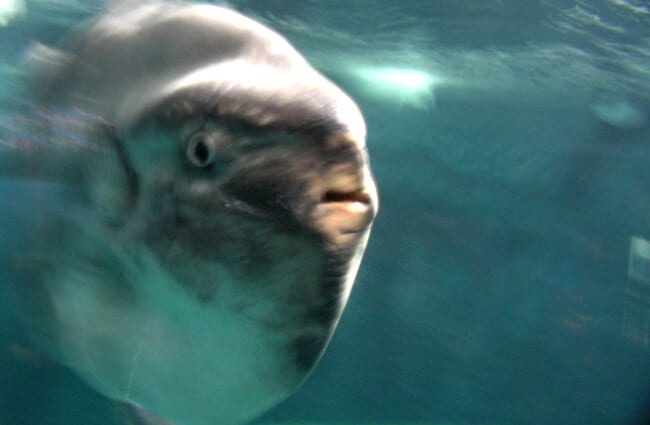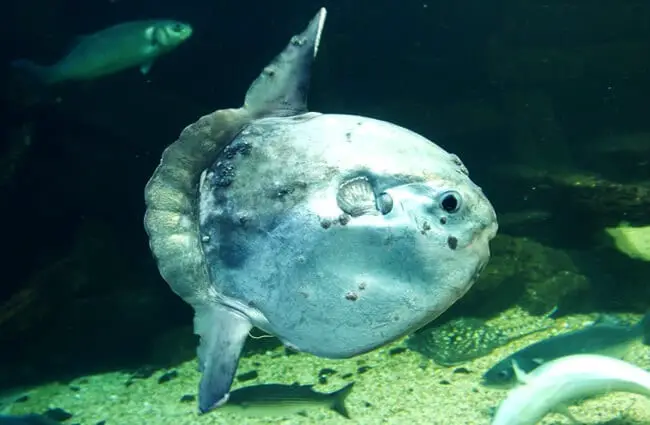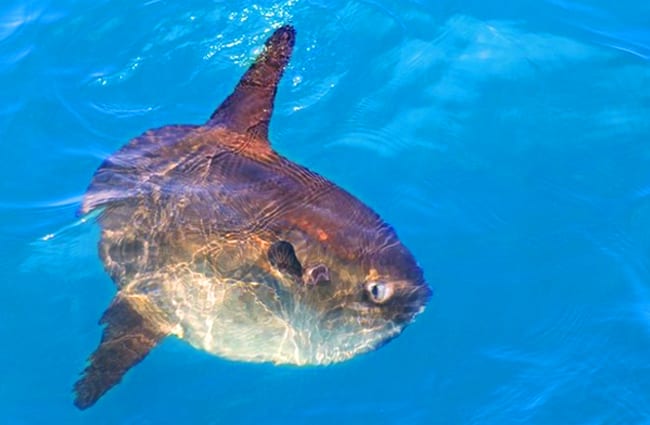Sunfish, also known as ocean sunfish, common mola, or mola mola, are large bony fish. They are actually the heaviest bony fish species in the world (a number of sharks are heavier, but they are cartilaginous fish.) These fish are pelagic, which means that they swim through the open ocean. This species is perhaps the strangest looking fish in the sea. Read on to learn about the sunfish.
Description of the Sunfish
It is difficult to describe the mola, because they don’t look like anything else in the ocean. This fish has a large flattened body, shaped almost like a giant guitar pick.
The pointed end of the body is the front, and the wider end is the tail. It has small pectoral fins, but its dorsal and anal fins are very long and narrow. These fins make the sunfish as tall as it is long.
Interesting Facts About the Sunfish
Sunfishes are interesting, to say the least. They are possibly the oddest-looking creatures in the sea, and that is saying a lot, when you consider anglerfish, goblin sharks, and basking sharks. They aren’t scary, like some other strange sea creatures are, just… really odd.
- Strange Shape – Instead of a typical triangular tail, or caudal, fin, these fish have something else entirely. They have a long rounded clavus. This odd appendage acts like the rudder on a boat, rather than a traditional tail.
- Swimming Scully – Without a proper tail, the sunfish must use another means of locomotion. Instead of moving its tail back and forth, it moves its long dorsal and anal fins side to side, in a “sculling” motion.
- Deep Diver – While these fish are commonly spotted near the surface, they actually spend most of their time in the depths of the ocean. They swim down as far as 2,000 ft. deep, and can travel a total of 16 miles in a single day.
- “Sun”fish – Molas are spotted near the surface because of their tendency to bask in the sun. They lie horizontally near the surface of the water, so their entire profile is flat. Scientists believe that this helps them thermoregulate before or after a long dive to the cold depths of the ocean.
Habitat of the Sunfish
These creatures are restricted to oceans with temperatures higher than 54º F. In areas with lower temperatures, these fish will become disoriented and eventually die, unless they move to warmer water. This is likely because they require surface basking to thermoregulate, and cannot thermoregulate in colder waters. The sunfish resides in temperate and tropical oceans across the world.
Distribution of the Sunfish
Living in tropical and temperate oceans across the world, these fish are very widespread, and even considered cosmopolitan. Though they may travel with ocean currents, they can swim up to 16 miles per day unaided.
While there are not different subspecies, the individuals in separate oceans can have very different appearances. Despite their different genotypes (genetic markers that alter appearance), they are still very closely related genetically.
Diet of the Sunfish
For a long time, people believed that these fish fed primarily on jellyfish, and similar organisms at the surface of the ocean. Additional research, however, has shown they that are actually much more opportunistic feeders.
They dive deep to hunt, and will feed on small fish, squid, shrimp, crabs, larvae, salps, and jellyfish. They also eat eel grass, and feed at all levels of the ocean, from the sea floor to the surface.
Sunfish and Human Interaction
While these huge creatures may look intimidating, they are incredibly docile and harmless. The only instances of sunfish causing harm are when individuals jump from the water and land on boats. Sadly, humans have detrimental interactions with sunfish very frequently. Like whales, boat strikes are common and can result in death.
Bycatch is a major problem for sunfish, and depending on the type of fishery, over half of the animals caught may be sunfish. For example, in the Mediterranean swordfish fishery, 70-90% of the total catch consists of sunfish bycatch.
Some fishermen see them as pests, and will needlessly cut the fins off of live animals before dropping them back into the ocean. These fish are slowly becoming valued in ecotourism, and gaining some protection and admiration.
Domestication
Sunfish have not been domesticated in any way.
Does the Sunfish Make a Good Pet
Because they can grow so incredibly large, it is virtually impossible to own a sunfish as a pet. They would require an incredibly large tank, with rounded edges and a large enough area to prevent the fish from hitting the edges. Basically, unless you can buy a few million gallon aquarium, you’re out of luck!
Sunfish Care
In a zoological setting, aquariums can only house these creatures when they have an incredible amount of space to dedicate to their care. Tanks must be large enough to allow these ungainly creatures to maneuver without hitting the edges of the tank.
Because they are so slow moving, humans must take extra care in feeding, when housed with other, faster moving, creatures. This makes them very difficult to accommodate. Only a few facilities across the world can, or have, housed these fish in aquariums. The Monterey Bay Aquarium is one facility that has successfully housed these animals.
Behavior of the Sunfish
While these fish are primarily solitary, they do occasionally travel in pairs, and do not appear to be aggressive towards one another. They spend short periods of time basking horizontally at the surface of the ocean, and then longer dives searching for food in the depths.
Scientists believe they cycle between basking and diving for food throughout the day. Though they are usually slow moving, they can swim rapidly when escaping predators, and have even been known to jump out of the water.
Reproduction of the Sunfish
Scientists know very little about the breeding practices of sunfish. Females are capable of producing as many as 300,000,000 eggs while spawning! The female releases the eggs into the water, and the male releases sperm to externally fertilize the eggs.
When the eggs hatch, the larvae are just 0.1 in. long. It quickly grows into a fry, which looks more like a tiny pufferfish than an adult sunfish. If the young sunfish survives, it can grow up to 60 million times its birth size!











![Red Angus Closeup of a beautiful Red Angus cowPhoto by: U.S. Department of Agriculture [pubic domain]https://creativecommons.org/licenses/by/2.0/](https://animals.net/wp-content/uploads/2020/03/Red-Angus-4-238x178.jpg)












![Red Angus Closeup of a beautiful Red Angus cowPhoto by: U.S. Department of Agriculture [pubic domain]https://creativecommons.org/licenses/by/2.0/](https://animals.net/wp-content/uploads/2020/03/Red-Angus-4-100x75.jpg)

